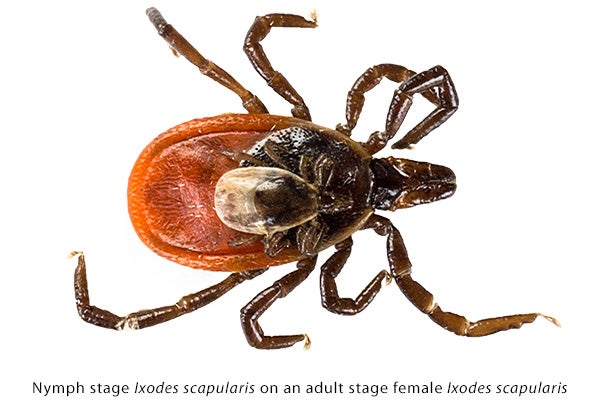Author: Cynthia E. Field
Since the middle of the Nineteenth Century, outdoor enthusiasts have enjoyed hiking along the Adirondack Mountains in eastern upstate New York. Every year, countless numbers of people savor the area’s magnificence as they pursue interests as wide-ranging as fishing, bird watching, rock climbing, and outdoor painting.
Just a few years ago, however, the Adirondack region began playing host to some unwelcome visitors: bloodthirsty, disease-carrying blacklegged ticks. Also called deer ticks, they’re sometimes as small as poppy seeds, and are just lying in wait along mountain trails, camp sites, fishing holes, and scenic overlooks, hoping for the arrival of their next meal.
These ticks have not gone unnoticed by residents of Fulton County.
“As a land surveyor, I and my field crew are outside every day. I have been doing this for over 25 years and for the first 20 years I never saw a tick,” remarked J. Christopher Foss, of Ferguson and Foss Professional Land Surveyors in Johnstown, NY.”
“Now it is a constant thing to check for them,” Foss said. “[People] have to realize they can go outside but they need to be careful,” he added.
Foss was one of more than 250 residents and medical professionals who packed a local hotel event room for the May 2012 Tick Town Hall Meeting sponsored by Nathan Littauer Hospital & Nursing Home, a 74-bed acute care hospital and 84-bed skilled nursing home in Gloversville, NY. Dr. Thomas Mather from the University of Rhode Island’s TickEncounter Resource Center gave the keynote address at the event.
“We are at the foot of the Adirondacks – and a gateway to many wonderful places in the mountains,” explained Cheryl G. McGrattan, the hospital’s Vice President for Marketing, Public Relations and Community Relations.
“Our county is also home to 44 lakes of varying size. We have many active residents. And we have many deer,” McGrattan explained.
McGrattan recalled her own personal Aha! deer-tick moment. She, her husband, and their then three year old son Rory had just returned from a walk in the woods – only to discover literally dozens of deer ticks crawling on them. Rory has since been diagnosed with Lyme Disease.
“In one fell swoop my confidence in unbridled play that I had enjoyed as a child was shattered,” McGrattan said. “I remember thinking as I was lying in bed [that evening], ‘Ugh! I’m thinking about ticks all the time now!”
From a seemingly innocuous walk in the woods McGrattan’s campaign to prevent tick-borne illness was born.
“I was talking to our head of Primary Care, a busy woman who manages eight primary care centers spanning a 60-mile radius when she said, ‘My goodness! We have received lots of calls about ticks this week.’ It was then that we set off to make our hospital the local resource for tick bite prevention,” McGrattan affirmed.
“The end result is that Nathan Littauer [Hospital] is seen as a tick literate place – a place where you can buy a candy bar and some permethrin [spray] in our gift shop,” McGrattan said.

As a TickEncounter Prevention Partner, Nathan Littauer Hospital offers tick magnetsand TickSmart™ Daily TickCheck Shower Cards to local residents – and to area campgrounds, as well. The hospital also hosts a microblog about ticks.
McGrattan credits the TickEncounter Prevention Partner program with making all of these initiatives possible.
“Put it this way: People see me coming and they tell me they immediately think ‘ticks,'” McGrattan chuckled. “I guess that’s a good thing.”

